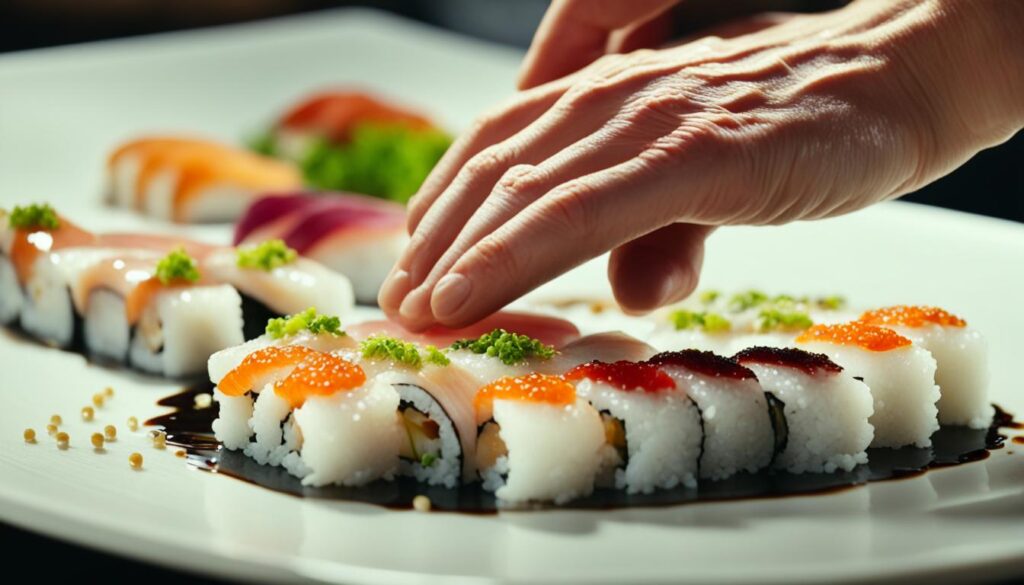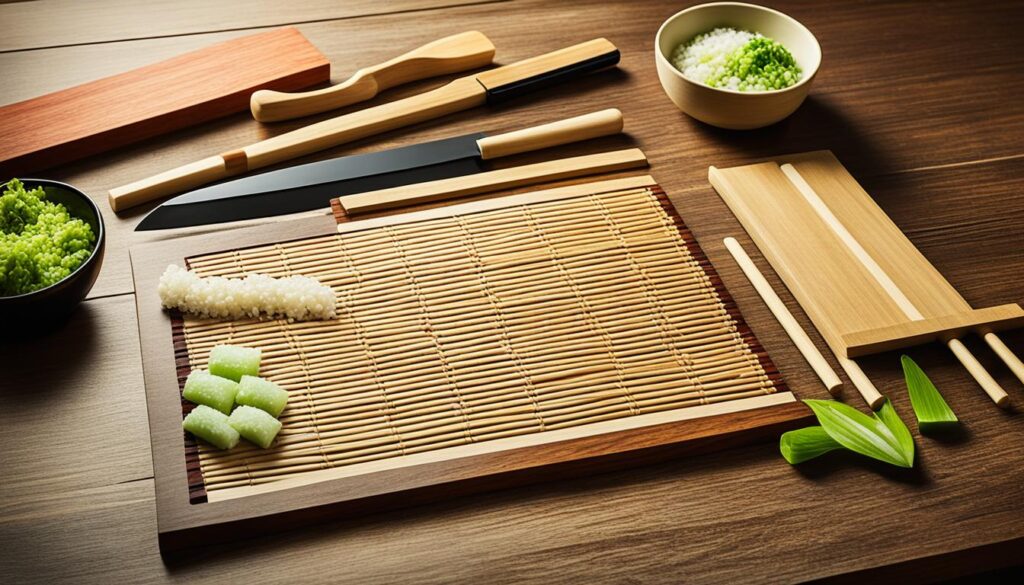Welcome to the fascinating world of sushi, where the delicate balance of flavors and the artful presentation create a culinary experience like no other. From the origins of sushi in ancient Japan to the modern techniques used by sushi masters today, this guide will take you on a journey through the art of sushi making.
Whether you’re a sushi enthusiast looking to expand your knowledge or an aspiring sushi chef eager to hone your skills, this comprehensive article will provide you with valuable insights and techniques to master the art of sushi.
Key Takeaways
- Explore the rich history and types of sushi, including nigiri, maki rolls, and sashimi.
- Understand the key elements of sushi making, such as preparing the perfect sushi rice and honing your knife skills.
- Learn about the essential tools and ingredients needed to create authentic and flavorful sushi.
- Discover the steps to rolling and presenting sushi like a true sushi master.
- Embrace patience and practice to become a sushi expert, and experiment with unique flavor combinations to create your own sushi creations.
With the knowledge and techniques gained from this article, you’ll be well on your way to becoming a sushi aficionado, impressing your friends and family with your sushi-making prowess. So, let’s dive in and unlock the secrets of the art of sushi making!
The Origins and Types of Sushi
When it comes to sushi, the art of creating these delectable bites is as fascinating as its taste. Let’s explore the origins and various types of sushi that have captivated taste buds for centuries.
The Origins of Sushi
Sushi has its roots in ancient Japan, where it evolved as a method of preserving fish. Interestingly, it started as fermented fish with rice and was consumed after the fermentation process. However, over time, the technique transformed, and the fermented fish was replaced with vinegared rice and fresh ingredients, giving birth to the sushi we know today.
“Sushi, with its delicate balance of flavors, textures, and presentation, is a true culinary art form. Its origins humble yet captivating.”
Types of Sushi
When it comes to sushi, there are several mouthwatering varieties to savor. Nigiri sushi, arguably the most well-known type, is a delicious combination of vinegared rice and thinly sliced fresh fish or seafood. The simplicity of nigiri allows the flavors to shine through.
Maki rolls, on the other hand, offer a delightful blend of textures and flavors. These cylindrical sushi rolls are wrapped in seaweed and filled with a variety of ingredients. From classic combinations like tuna and avocado to innovative options like tempura and cream cheese, maki rolls present endless possibilities.
Although not technically sushi, sashimi deserves a mention due to its prominence in Japanese cuisine. Sashimi features thin slices of raw fish or seafood served without rice. Its pure simplicity highlights the freshness and delicate flavors of the ingredients.
Understanding the different types of sushi is crucial in mastering the art of sushi making. Each variety offers a unique taste experience, showcasing the diversity and creativity behind this beloved Japanese cuisine.
Key Elements of Sushi Making
Sushi making is a delicate art that requires a combination of skills and attention to detail. To create a truly authentic and mouth-watering sushi experience, several key elements must come together harmoniously. These elements include the preparation of sushi rice, knife skills, and the use of fresh ingredients. Let’s explore each of these elements in detail:
Sushi Rice Preparation
The foundation of every delicious sushi creation is the rice. Sushi rice is not just any kind of rice—it is a carefully prepared blend of short-grain rice, rice vinegar, sugar, and salt. The rice needs to be perfectly cooked, with the right amount of stickiness and texture to hold the shape when rolled or shaped. Achieving this balance is essential to ensure that every bite of sushi is a perfect mouthful.
Knife Skills
Knife skills are crucial for sushi making, as precision cuts enhance both the presentation and the texture of the sushi. A skilled sushi chef knows how to handle a sharp knife with finesse, creating clean and precise cuts that showcase the freshness and quality of the ingredients. From thinly slicing fish to cutting vegetables into elegant shapes, knife skills are an essential aspect of mastering the art of sushi making.
Fresh Ingredients
One of the pillars of sushi making is the use of fresh and high-quality ingredients. From the fish and seafood to the vegetables and condiments, sourcing the best ingredients is paramount. Freshness not only impacts the taste of the final dish but also ensures food safety. Using top-notch ingredients allows the flavors to shine and elevates the overall sushi experience.
By paying attention to the key elements of sushi making—sushi rice preparation, knife skills, and fresh ingredients—you can take your sushi creations to new heights. With practice and dedication, you’ll be able to create beautiful and delicious sushi that will delight your taste buds and impress your friends and family.

| Key Elements of Sushi Making | Description |
|---|---|
| Sushi Rice Preparation | The foundation of every sushi masterpiece. The rice must be perfectly cooked, with the right stickiness and texture. |
| Knife Skills | Precision knife cuts enhance the presentation and texture of the sushi, showcasing the freshness of the ingredients. |
| Fresh Ingredients | Top-quality ingredients are essential for authentic and delicious sushi. Freshness enhances flavors and ensures food safety. |
Becoming a Sushi Expert
Becoming a sushi expert is a journey that requires time, practice, and dedication. To master the art of sushi making, consider enrolling in a sushi making course. These courses provide valuable hands-on training and insights into traditional techniques from experienced sushi chefs.
“Attending a sushi making course allowed me to learn from the best in the industry. Not only did I gain practical skills, but I also developed a deeper understanding and appreciation for the artistry behind sushi making.” – Michelle, sushi enthusiast
Investing in quality tools is another essential step in your quest to become a sushi expert. Below are some recommended sushi tools that can significantly enhance your sushi-making process:
- A sharp chef’s knife for precise and clean cuts
- A bamboo sushi mat for rolling perfect maki rolls
- A rice cooker to ensure consistently cooked sushi rice

Practicing patience is key to perfecting your sushi-making skills. Rome wasn’t built in a day, and neither is sushi mastery. Take the time to understand the fundamentals and techniques, and don’t be afraid to make mistakes along the way. Experimenting with different flavors and combinations is another way to develop your unique sushi creations.
Tips for Flavor Experimentation:
- Try pairing traditional sushi ingredients with unexpected flavors, like citrus zest or spicy chili oil.
- Explore different types of seafood and experiment with texture and flavor contrasts.
- Incorporate seasonal and locally-sourced ingredients for a fresh and unique twist on classic sushi.
Remember, becoming a sushi expert is a journey that requires continuous learning and practice. Embrace the process, and soon enough, you’ll be rolling out sushi masterpieces that will impress friends and family.
Conclusion
Sushi is more than just a meal; it’s a captivating experience that combines history, craftsmanship, and gastronomy. Through understanding the art of sushi making, from its origins to the various types and techniques, you can truly appreciate the beauty and complexity of this culinary art form.
Whether you dream of becoming a sushi master or want to refine your sushi-making skills at home, embarking on this journey will be immensely rewarding. It’s a chance to delve into the rich history and culture surrounding sushi, and to explore the endless possibilities of flavor combinations.
So, roll up your sleeves, sharpen your knives, and let the art of sushi mastery unfold in your hands. With practice, patience, and attention to detail, you can create exquisite sushi that not only delights the senses but also showcases your passion for this ancient craft.
As you continue to explore the art of sushi making, remember to embrace the artistry and precision it demands. Allow yourself to experiment with flavors, ingredients, and presentation, while respecting the traditional techniques that have been refined over generations. The art of sushi making is a never-ending journey of growth and discovery, where each roll and slice unlocks a new level of sushi appreciation.
















